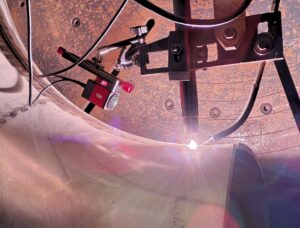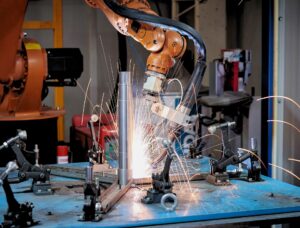Why real-time weld monitoring is becoming essential in nuclear environments
In this blog, we’ll compare real-time vs recorded welding footage and examine how both video inspection methods contribute to effective quality control and defect detection workflows. As welding technology advances, video inspection has become a valuable tool for monitoring weld quality, operator performance, and overall productivity. Thanks to industrial weld monitoring systems, inspectors can now view the weld pool, arc behavior, and joint condition in real time—or review recorded footage after the fact. But which is more effective for quality control and defect detection? Let’s break down the advantages and limitations of both real-time and recorded welding footage and explore how they can work together to improve inspection workflows.
Real-Time Monitoring: Fast and Proactive
Welds in nuclear plants are not just structural—they are safety-critical components. They’re responsible for sealing Real-time footage gives inspectors or operators a live view of the welding arc, allowing them to identify potential problems as they happen. This approach is especially beneficial when welding critical joints, working on high-value materials, or operating in hazardous or remote environments.
Benefits of real-time weld monitoring:
- Immediate detection of issues like lack of fusion, porosity, or arc instability
- Quick response to incorrect travel speed or torch angles
- Enhanced operator awareness during manual or semi-automated welding
- Valuable in environments where physical access is limited or dangerous
Real-time visuals are ideal for preventing weld defects before they occur, reducing rework, and ensuring consistency in automated or robotic processes.
Limitations:
- No record for post-weld analysis or documentation
- Requires an operator or inspector to be present during the weld
- Mistakes or anomalies can be missed if attention lapses
Recorded Footage: Detailed, Reviewable, and Traceable
reviewed frame by frame, stored for long-term traceability, and used for training, quality audits, and post-weld analysis.
Advantages of recorded footage:
- Enables inspectors to pause, rewind, and closely analyze weld behavior
- Supports documentation and compliance for critical welds
- Allows remote teams or third-party inspectors to review work off-site
- Useful for identifying root causes of hidden defects or failures
- Helps with operator feedback and continuous improvement
Recorded video is especially useful in industries like nuclear, aerospace, and pipeline construction, where every weld must be documented and verifiable.
Limitations:
- Problems are identified after the weld is complete, which may require costly repairs
- Storage and management of video files can be a challenge for large projects
- Not effective for immediate intervention or real-time corrections
Which Is Better?
| Scenario | Recommended Option |
| Preventing weld defects during fabrication | Real-Time Monitoring |
| Post-weld analysis and troubleshooting | Recorded Footage |
| Operator training and technique evaluation | Recorded Footage |
| Remote or hazardous work environments | Real-Time (with optional recording) |
| Meeting compliance and documentation standards | Recorded Footage |
| Automated or robotic welding processes | Both Real-Time & Recording |
In most cases, the best approach is a combination of both: real-time monitoring for immediate quality control, and recording for documentation and deeper analysis.
Final Thoughts: Real-Time vs. Recorded Welding Footage
Welding cameras have made it possible to see the weld as it happens—and to preserve those visuals for later inspection. By understanding the strengths of both real-time and recorded footage, welding teams can build more robust quality assurance systems, catch problems faster, and reduce the risk of undetected weld failures.
Need a Camera System That Does Both?
Our welding cameras are designed for real-time monitoring with built-in recording capabilities—ideal for projects that demand both speed and accountability. Contact us to learn more or request a demo.



